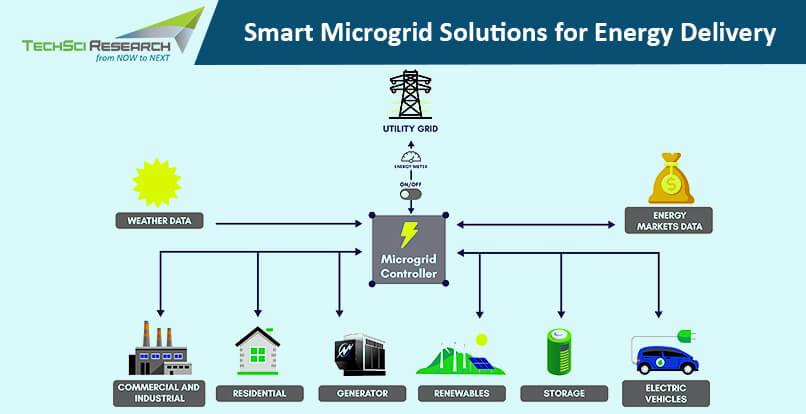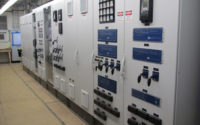Microgrid Control Technology: The Future of Energy Resiliency
The world is edging closer to a worldwide energy catastrophe, with increasing global population and exacerbating energy demands. Loss of grid electricity can significantly affect mission-critical operations, which might have disastrous effects on businesses. Microgrids can significantly contribute to improving energy efficiency by permitting localized power generation, delivery, and consumption. They frequently combine a number of environmentally friendly technologies, are safe, and versatile. Along with more conventional yet “smart” monitored energy sources, they also incorporate wind and solar energy. In order to serve their intended customer footprint, microgrids have the ability to “island” themselves from a major regional grid. By islanding, they are able to dynamically regulate the connection to the external grid, giving electricity to their customers while drawing more from the main grid during periods of high demand. Increasing emphasis on decarbonization by governments and expansion of utility-based grids for supplying electricity to remote areas are expected to drive the growth of microgrids in the coming years.
Microgrids Technology: Essential Blocks of Future Electricity
By integrating Distributed Energy Resources (DERs) such as solar panels, wind turbines, and tiny generators into microgrids, local power generation can be made possible in remote areas. This improves energy efficiency by lowering transmission losses linked to long-distance power transmission. Besides, microgrids improve localized electricity delivery to support efficient load control. The demand, peak consumption, and grid stability can be used to determine the order of power allocation. Additionally, demand response programs are made possible by microgrids, allowing customers to modify their power use during peak hours to ease system stress.

Microgrids incorporate energy storage technology such as batteries, flywheels, or compressed air systems. These energy storage technologies make it possible to collect and store extra power produced when there is little demand for it. Then, at times of high demand, the stored energy may be used, lowering the need for extra generation, and raising total energy efficiency. During grid disturbances or outages, microgrids offer localized resilience by functioning independently or autonomously from the main grid. Microgrids increase overall energy efficiency by minimizing downtime and avoiding losses associated with power outages by sustaining power supply during crises.
The best possible use of renewable energy is encouraged through microgrids, which help these sources be included into the neighborhood grid. They can take advantage of the dynamic nature of renewable resources by achieving supply and demand equilibrium within a more constrained geographical region. As a result, renewable energy sources can be used more often and the demand for fossil fuel-based generation is diminished, resulting in increased energy efficiency and a cleaner energy mix. By dispersing power generation closer to the point of consumption, microgrids enhance grid decentralization and reduce transmission losses. When electricity is transmitted over long distances, this lessens the transmission and distribution losses that happen. Microgrids help to increase energy efficiency and resource conservation by reducing these losses.
This way, microgrids enhance energy efficiency by promoting localized power generation, load management, demand response, energy storage integration, grid resilience, optimal utilization of renewable energy, reducing transmission losses, and enabling energy efficiency monitoring and optimization. These features make microgrids a valuable tool in achieving a more sustainable and efficient energy system.
Schneider Electric, one of the global leaders in microgrids market, recently introduced all-in-one standardized microgrid solution, EcoStruxure Microgrid Flex. The innovative solution not only reduces project timelines across the journey, but also delivers a greater ROI for the system. With EcoStruxure Microgrid Flex, projects for microgrid systems can be finished more quickly—in months as opposed to years—from specification to design and construction. In addition, Schneider Electric has started leveraging unusual resources into microgrids built in remote areas such as river currents. For this purpose, the industry giant has partnered with ORPC, a company that offer RivGen Power System. Schneider was drawn to river generation because it offers isolated areas that cannot readily or affordably link to a central grid a substitute for diesel fuel.
More electric vehicles mean more utility microgrids
The demand for electric vehicles (EVs) is anticipated to rise sharply as a result of policy, economic, and environmental concerns; this development is encouraging the development of additional utility microgrids. In order to benefit from EV batteries’ potential to sustain the grid and to assist meet the increasing demand for power from EV charging, three utilities, including Florida Power and Light (FPL), Portland General Electric (PGE), and Pacific Gas & Electric (PG&E), intend to install microgrids. The Biden-Harris Electric Vehicle Charging Action Plan, a result of the Bipartisan Infrastructure Law, which calls for the establishment of a public charging network with a focus on access to rural and underprivileged regions, is one of the driving forces behind the predicted EV boom. It should enable the Biden administration to fulfil its pledge to install 500,000 chargers nationwide.
According to projections from the Federal Energy Information Administration, the percentage of EVs in the fleet of light duty cars will rise from less than 1% in 2020 to 30% in 2050. Microgrids can be useful in situations where energy management or resiliency is essential to the purpose of the EV client since they play a significant part in creating a clean, adaptable, and resilient system in favor of a sustainable energy future.
A microgrid enables networks to handle demand in a way that puts less strain on the grid by offering dynamic energy management and on-site energy storage, which results in far better energy management and distribution systems. Solar energy can be stored in on-site batteries and then utilized to charge EVs when electricity rates are high during peak hours thanks to a local sustainable power grid. Simply said, it enables charging at any moment without causing the grid to become unstable. Besides, microgrid systems are very adaptable and software-driven, allowing for simple updates and more management.
Role of Microgrids in Energy as a Service Model
Microgrids are essential to the Energy as a Service (EaaS) model because they offer a specialized and effective energy solution locally. The EaaS concept views energy as a service rather than a good, with a focus on giving users access to dependable, affordable, and clean energy. This concept fits neatly with the benefits that microgrids provide. Microgrids make it possible to combine various energy resources, including energy storage devices and renewable energy sources like solar and wind power. Because of their adaptability, microgrids may tailor energy production and delivery to meet the individual demands of their users. Microgrids can promote a better energy mix and lower greenhouse gas emissions by combining renewable energy sources.
By reducing transmission and distribution losses, microgrids improve energy efficiency. Microgrids reduce the need for long-distance transmission, which can cause large energy losses, by producing power near to the point of consumption. This regional strategy lowers waste and raises overall energy effectiveness.
Moreover, microgrids assist load management and demand response initiatives. Microgrids may actively regulate and balance energy supply and demand within the localized region using sophisticated monitoring and control systems. This facilitates effective resource use, particularly during periods of high demand, and gives users the ability to modify their energy use to maximize effectiveness and cost.
Microgrids also improve the resiliency and dependability of the grid. Microgrids can function independently or autonomously in the case of grid interruptions or power outages, maintaining a constant supply of electricity to clients. This resilience is especially useful in isolated locations, places at risk for natural catastrophes, or important infrastructure sites, where a dependable energy source is crucial.
Microgrids enable a change from a conventional centralized energy system to a more customer-centric, environmentally friendly, and effective strategy under the EaaS model. Microgrids significantly contribute to the successful implementation of the Energy as a Service model, ultimately benefiting both consumers and the environment, by offering dependable and clean energy, minimizing losses, supporting demand response, enhancing grid resilience, and encouraging local empowerment.
Challenges for Microgrids
Currently, microgrids account for 0.2% electricity in the US and are heavily concentrated to just a few states. As microgrids are highly customizable, they require high investments and take longer time to market. Without considering location, energy mix, or use, the National Renewable Energy Laboratory estimates that microgrids can cost between USD2 million and USD4 million per MW. Companies interested in investing in microgrids must have the funds on hand or know how to get financing while predicting their projected return on investments. Besides, microgrids tend to complicate the power distribution equation, which limit their widespread equation. However, standardizing microgrid design and implementation can mitigate these challenges and drive the adoption of microgrid technology, which could contribute to a greener future.
Future of Microgrids
Future power systems are expected to witness an increase in the usage of distributed energy resources by up to 30-50%. This might pose a challenge for utility operators in coordinating dispersed energy resources like microgrids or to minimize variations in power flow during grid-connected operation. Microgrids are anticipated to grow in terms of installation volume, as well as in terms of size and geographic reach. Additionally, it is anticipated that groups of networked microgrids, both utility- and customer-owned, will be able to connect on distribution networks to boost efficiency and reliability by utilizing more diverse loads, more generators, and multiple paths between generation and loads. Networked microgrids can operate in terms of supplying black start capability and protection coordination thanks to new sensor technologies, protection systems, and inverter controls.
According to TechSci Research report on “Microgrid Control Systems Market – Global Industry Size, Share, Trends, Opportunity and Forecast, 2018-2028, Segmented By Grid Type (On-Grid and Off-Grid), By Component (Hardware and Software), By Ownership (Private and Public), By End User (Utilities, Campuses & Institutions, Commercial & Industrial, Defense, Others), By Region, Competition Forecast”, the global microgrid controls systems market is projected to grow at a formidable rate during the forecast period. The market growth can be attributed to the rising government investments in microgrid projects and increasing demand for dependable and secure power supply.



